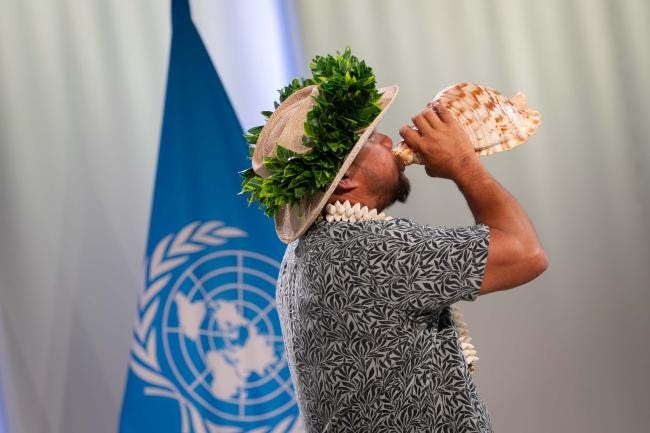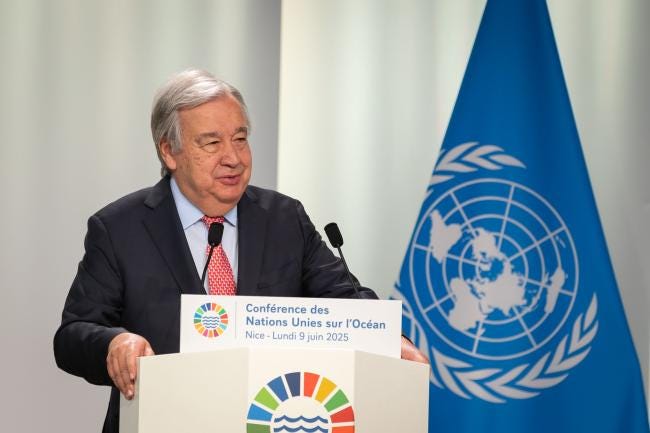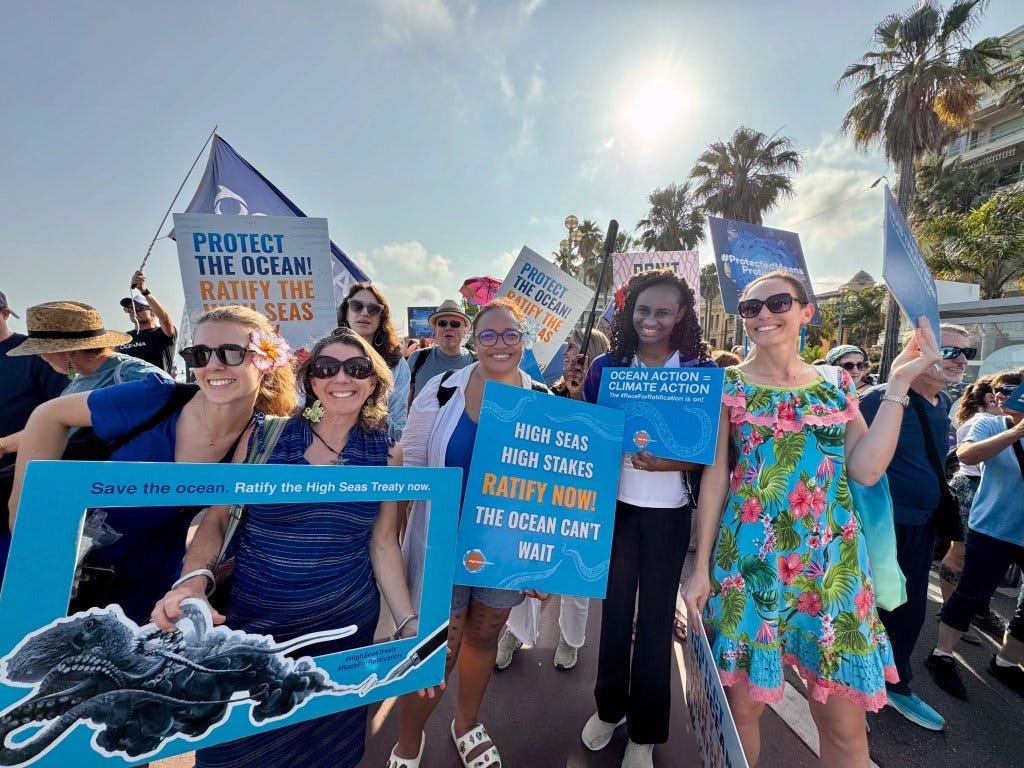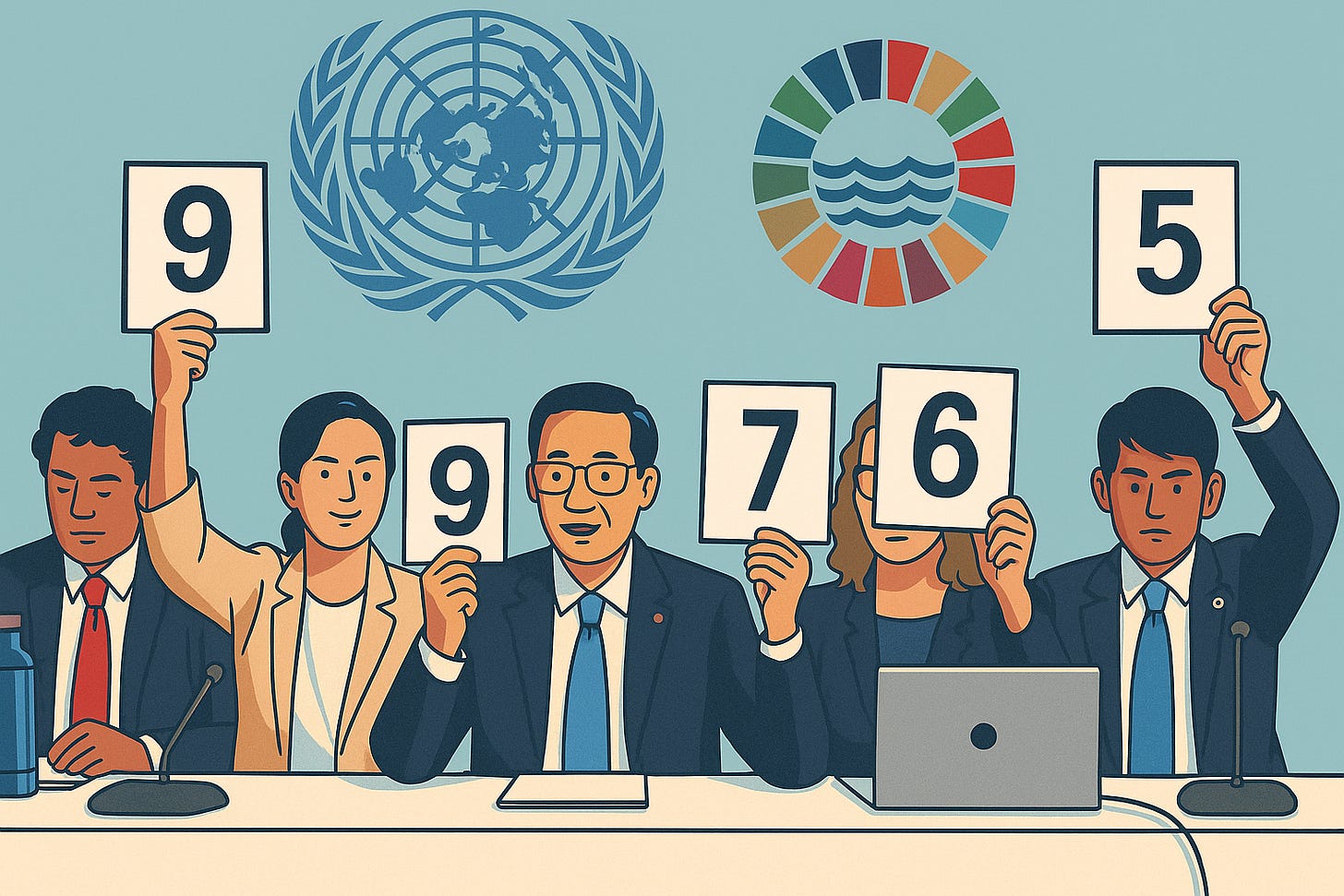Are the UNOC Commitments bold promises or simply bluewash?
What the UN Ocean Summit pledged, what they missed and why it matters now more than ever
TL;DR: Seven Promises. One Ocean. Zero Guarantees.
At the UN Ocean Conference in Nice, world leaders announced seven major pledges, from protecting high seas biodiversity to ending harmful fishing subsidies. These are not binding. Many recycle existing promises. None have funding or enforcement built in.
Five key issues were conspicuously absent, including shipping, seabed mining and the rights of coastal communities.
I’ve rated each pledge by potential impact and likelihood of implementation. Most fall short on political will.
This isn’t the first time ocean promises have made headlines and quietly vanished.
If we want real change, we have to pay attention, apply pressure and remember what was promised long after the conference ends.
A global audience is still asking, did anything real happen in Nice?
I wasn’t at the UN Ocean Conference in person, but like thousands of ocean advocates around the world, I’ve spent the past week knee-deep in pledges, press briefings and political theatre, trying to answer that question.
The short answer… maybe.
The long answer is buried in one ambitious document, The Nice Commitments for the Ocean.

Making Sense of the Ocean Summit
When I first got into conservation, I often found myself wondering what the bloody hell everyone was talking about. Summit declarations. Framework agreements. Treaty texts. It all felt deliberately complex, like the real decisions were buried in acronyms and diplomatic code.
So, I’ve done what I wish someone had done for me… broken it down so anyone and their dog can (hopefully) understand.
With dozens of pages of outcomes, press releases and political speeches, it’s easy to lose sight of what world leaders actually promised at the UN Ocean Conference.
That’s why I’ve zeroed in on seven key commitments. These are the most specific and trackable promises, backed by real negotiations, treaties, or targets
Each one:
Is clearly stated in the final outcome text
Has a real process behind it (like treaty ratification or UN votes)
Can be tracked over time to see if it really happens
I’ve chosen them because they’re specific (e.g. “ratify the High Seas Treaty”), measurable (e.g. “protect 30% of the ocean by 2030”), and global in scope.
Of course, these seven aren’t the only things that matter. Other important themes from the conference included support for women in marine science, ocean literacy, better data sharing and a shift towards more sustainable ocean economies. These are all crucial, but harder to measure or enforce.
The seven commitments I’ve focused on are the backbone of what countries say they’ll deliver between now and 2030. They represent the most tangible next steps.

How They Measure Up
I’ve decided to rate each of the seven headline commitments (think Tom Daley and Olympic Diving), not as a cynical exercise, but to help more people understand what’s really going on. After all, they’re meant to be the most explicit, trackable actions the world will deliver by 2030.
My rating system is simple. I score each commitment out of ten for:
Impact – How much good it could do for the ocean
Likelihood – How realistic it is, based on law, politics and funding
The impact score reflects the potential benefit to ocean health, for biodiversity, climate resilience and human communities. I looked at scale, ambition and reach.
The likelihood score is based on three core tests:
Ratifiability – Does it need legal action, and has that started?
Finance – Has money been pledged, redirected or requested?
Feasibility – Has anything like this been done before?
This isn’t a scientific index. It’s one conservation professional’s read of how these promises measure up, shaped by two decades of working across the spectrum of ocean protection.
As a side note, you'll hear the word ratify a lot at these sort of conferences. Simply put, if a country ratifies a treaty they are saying “We’ve made it official law in our country”.

So, strap in, here they are, the seven headline commitments, rated and explained:
1. Finalise and ratify the High Seas Treaty
Translated: The High Seas Treaty is shorthand for the very long worded ‘agreement on the conservation and sustainable use of marine biological diversity of areas beyond national jurisdiction’ or BBNJ Agreement for short. It is global agreement that would allow countries to create marine protected areas in the parts of the ocean that lie beyond any one nation’s borders. These waters, known as the high seas, cover almost half the planet and currently have almost no meaningful protection. Companies can fish, mine and explore them with little oversight.
Why it matters: This is the most potentially transformative pledge. The treaty text was agreed in March 2023 and opened for signature in September 2023.
As of June 2025:
91 countries have signed
50 have ratified (19 at UNOC itself)
60 ratifications are needed for it to enter into force (Source: UN Treaty Collection – BBNJ Agreement)
Real world implications if successful: The world could see the first truly global network of protected areas, preventing deep-sea mining in vulnerable habitats, banning destructive fishing practices, and safeguarding biodiversity in regions previously treated as a free-for-all.
Hurdles to success: Some countries are stalling ratification due to geopolitical tensions, domestic legal hurdles, or fears of losing access to marine resources. Coordination among regional bodies may also slow implementation.
Impact: 9 / 10
Likelihood: 7 / 10
2. Ensure access to finance for small island developing states (SIDS)
Translated: Small Island Developing States are on the front lines of the climate crisis. They contribute the least to the problem and face the worst impacts, including rising seas, cyclones and coral loss. This commitment aims to ensure they get fair and reliable access to climate finance.
“The ocean ecosystems don’t follow national boundaries… we need a governance framework that reflects that reality.” - Surangel Whipps Jr., President of Palau, speaking at UNOC3
Why it matters: SIDS often struggle to access international funding due to bureaucracy and eligibility rules. This one breaks from the treaty track. It’s about unlocking finance from global mechanisms such as the Loss and Damage Fund, Blue Bonds, and simplified access to the Global Environment Facility (GEF) could help.
Real world implications if successful: Local communities could invest in sea walls, early warning systems, marine education, and sustainable fishing. Coral reefs and coastal defences would be strengthened. Countries facing existential risk could receive the funding they deserve to adapt and thrive.
Hurdles to success: Accessing funds still requires complex proposals, co-financing, and institutional capacity. Many SIDS lack the staff and systems to meet donor requirements or absorb large-scale funding quickly.
Impact: 8 / 10
Likelihood: 7 / 10
3. Agree an ambitious, legally binding international instrument to end plastic pollution
Translated: Governments are negotiating a global treaty to stop plastic pollution. They have yet to agree on whether to reduce plastic production or simply improve recycling and waste management.
Why it matters: An ambitious treaty could transform industries, ban toxic additives and phase out unnecessary plastics.
As of June 2025:
No treaty has been adopted
Final negotiations (INC-6) expected by early 2025, with adoption hoped for later that year (Source: UNEP INC Secretariat)
Real world implications if successful: An ambitious treaty could transform industries, ban toxic additives and phase out unnecessary plastics.
“The issue is pollution. The issue is not plastic. A limit on plastic production will not serve us in terms of pollution and the environment.” - Karen McKee, Head of Product Solutions for ExxonMobil
Hurdles to success: Lobbying from major petrochemical producers such as ExxonMobil, BASF and Dow remains a barrier. Also, deep divisions between countries advocating production caps and those favouring voluntary action or downstream measures (recycling etc.).
Impact: 8 / 10
Likelihood: 5 / 10
4. Increase the volume and effectiveness of ocean-based climate action
Translated: This commitment is about channelling more climate funding into ocean solutions, such as mangrove restoration, seaweed farming and sustainable marine economies.
Why it matters: The ocean receives just 1% of global climate finance, despite absorbing over 90% of excess heat (World Bank, 2022).
Real world implications if successful: Millions could be invested in nature-based solutions that slow climate breakdown, protect coasts and boost livelihoods. Blue carbon ecosystems, such as mangroves, seagrasses and salt marshes, would be protected and expanded. Initiatives such as the Ocean Breakthroughs and the High-Level Panel for a Sustainable Ocean Economy are supporting this effort.
Hurdles to success: Most climate finance channels don’t prioritise marine solutions. Ocean-climate links remain poorly understood in key financial and policy institutions.
Impact: 7 / 10
Likelihood: 6 / 10
5. Strengthen action to end illegal, unreported and unregulated (IUU) fishing
Translated: This is about cracking down on fishing that breaks the rules, especially by foreign fleets operating in waters with little oversight.
Why it matters: IUU fishing causes an estimated $10 to $23 billion in global losses every year. It devastates local fish stocks, undermines conservation and deprives communities of food and income.
One key enforcement tool is the Port State Measures Agreement (PSMA):
78 countries have ratified
The agreement is in force
(Source: FAO PSMA Database)
Real world implications if successful: Ports would refuse entry to illegal vessels. Global seafood markets would be cleaner. Small-scale fishers could regain control of local stocks. China has ratified PSMA, although enforcement remains a concern.
Hurdles to success: Capacity gaps in coastal states, limited vessel tracking infrastructure, political reluctance to confront powerful distant-water fleets.
Impact: 7 / 10
Likelihood: 4 / 10
6. Deliver and implement the World Trade Organisation agreement on fisheries subsidies
Translated: Some governments give subsidies that encourage overfishing, such as paying fuel bills or upgrading massive trawlers. The WTO agreed to curb this in 2022, but it only takes effect once enough countries ratify.
As of June 2025:
71 countries have ratified
110 are needed
(Source: WTO Subsidy Tracker)
Why it matters: Without subsidy reform, depleted fisheries may never recover. The first agreement covers illegal fishing. A second round is under negotiation to target subsidies contributing to overcapacity and overfishing.
Real world implications if successful: Unsustainable industrial fishing would lose its unfair advantage. There would be more equitable access to fish stocks and better prospects for coastal communities.
Hurdles to success: Some developing countries fear losing economic lifelines for their fleets. Ratification requires domestic reforms that may face political resistance.
Impact: 6 / 10
Likelihood: 3 / 10
“Only a fraction of 1% of philanthropy goes to Indigenous ocean stewardship. We need to expand the pie, with new ocean philanthropists, not just cut it into smaller pieces.” - Bodhi Patil, UN Ocean-Climate Solutionist, speaking at UNOC3
7. Support the implementation of the 30x30 global biodiversity framework target
Translated: This target calls for 30% of the ocean to be protected by 2030. It was adopted under the Kunming-Montreal Global Biodiversity Framework in 2022 and needs major buy-in, monitoring and enforcement.
Why it matters: Just 8% of the ocean is protected, and much of it is not effectively managed.
Real world implications if successful: Vast swathes of marine life would gain legal safeguards. Coral reefs, migratory corridors and breeding grounds could be shielded from exploitation. This could be the biggest leap in conservation ever achieved.
Hurdles to success: Many countries lack funding, legal frameworks or political will to expand or enforce marine protected areas. There are also concerns about fairness, especially if local communities or Indigenous groups are excluded.
Impact: 9 / 10
Likelihood: 5 / 10
If you found this breakdown helpful, please like and share it to help others understand what just happened at UNOC, and what it might mean for them.
What Was Missing?
I have been speaking to a number of my colleagues to get their take on what was missing, and we were pretty much all in agreement. While the seven commitments reflect strong diplomatic consensus, major gaps remain, some of them so fundamental that their omission risks undermining the rest.
Shipping Emissions
Global shipping is responsible for over 3% of global carbon emissions, more than Germany, Japan or the UK. Yet it sailed through UNOC largely unchallenged. While the International Maritime Organisation has pledged net-zero by 2050, it lacks binding targets, enforcement tools or interim milestones. Without meaningful regulation, the sector will continue polluting freely.
Impact if addressed: 8 / 10
Sewage and Wastewater Pollution
More than 80% of global wastewater flows into the ocean untreated, carrying pathogens, microplastics, pharmaceuticals and excess nitrogen. It fuels toxic algal blooms, dead zones and coral collapse. It threatens food security and public health. Despite its scale and solvable nature, sewage didn’t make the agenda in Nice. That silence could cost millions in marine health, and human lives.
Impact if addressed: 9 / 10
Deep Sea Mining Moratorium
Deep sea mining is on the brink of commercial launch. If allowed to proceed, it could destroy fragile ecosystems before they’re even fully discovered. UNOC3 acknowledged the controversy, but fell short of a moratorium. Without a global pause, corporate ambition will outpace science and irreversible damage will follow.
Impact if addressed: 7 / 10
Marine Genetic Resources & Benefit Sharing
Pharmaceutical and biotech companies are patenting the DNA of deep-sea life. These organisms hold potential cures and billion-dollar applications. Who owns them? Who benefits? Right now, the answer is whoever gets there first. Without global frameworks for equity and benefit-sharing, this modern ocean bioprospecting will continue unchecked, exploiting biodiversity without reinvesting in it.
Impact if addressed: 6 / 10
Shipping Noise Pollution
Whales, dolphins, fish and countless marine species rely on sound to feed, mate and navigate. Yet chronic noise from global shipping is rising year after year, disrupting life at every level of the marine food chain. It leads to stress, habitat abandonment and even mass strandings. The launch of the High Ambition Coalition for a Quiet Ocean is a welcome signal but at UNOC, real policy on noise pollution was absent. Silence has a cost.
Impact if addressed: 8 / 10
These absences matter. They signal where resistance remains strongest and where public pressure is most urgently needed.
What Now?
If like me, you still believe that there is hope for our ocean, you will want to track the progress of these commitments. You can do so by watching out for the following milestones:
November 2025 – COP30 in Brazil: Countries will meet under the UN climate framework. Expect updates on finance delivery, treaty progress and national ocean-climate plans.
June 2028 – UNOC4 in Chile and South Korea: The next official UN Ocean Conference. Governments will be expected to show delivery, not just diplomatic progress.
Treaty ratification monitoring: Follow the UN Treaty Collection, Earth Negotiations Bulletin and WTO dashboards.
Finance transparency: OECD and World Bank reports will show whether ocean funding increases beyond 1%.
In Conclusion
These commitments could shape the future of the ocean. I so hope they do.
They carry the potential to protect vast marine ecosystems, hold destructive industries accountable and give frontline nations the resources they urgently need.
However, potential means little without follow-through.
Many of these pledges rely on future ratifications, legislative action and shifts in global finance. The road from promise to progress is long, and history tells us that ocean commitments often stall when power meets politics.
That is why scrutiny matters.
The ocean cannot speak for itself. Those of us who care can pay attention, ask hard questions and stop these pledges from being quietly buried. We can track who delivers and who delays.
This article is a starting point. I look forward to the day I can score ten out of ten across the board for impact, for likelihood and for delivery. That is what the ocean needs, and that is what the world depends on.
I have fought incredibly hard not to come across as cynical in this article, as history makes it hard not to be. Too many pledges have faded once the cameras stop rolling.
Still, I believe in what’s possible when people pay attention, stay involved and refuse to let these promises be forgotten. We’ve been here before, but we can write a new ending.
“Our ocean has not only shaped cultures, stirred imaginations and inspired wonder across the ages… it supplies the air we breathe, the food we eat, the jobs we need and the climate we count on. But today, the ocean needs our help.” - Rodrigo Chaves, President of Costa Rica, speaking at UNOC3
If this story resonated, feel free to share it with someone who cares about the ocean too. You can also subscribe to Voice for the Blue to get these dispatches direct each week, no noise, just the stuff that matters.
— Luke
📌 PS: Likes and Restacks go a long way. This is a community, not a campaign.







Thank you for this thorough and thoughtful analysis, Luke. The outcome appears hopeful, although, as you point out, there are some significant gaps and only time will tell whether we see follow-through on the commitments. Fingers crossed!
This is so helpful! Thank you Luke. I was at UNOC3 and, pessimism aside, it was overwhelming in a good way to see how many organisations are involved in all areas of ocean conservation, that this crisis is fixable, and there are many more people out there committed to help, than the general public might think!
Is there an easy way to follow some of the resources you mentioned?
- The UN Treaty Collection? I found the website but no link for updates.
Earth Negotiations Bulletin, found this where people can sign up to updates: https://enb.iisd.org/get-updates
WTO dashboards - do you have any links?
And then, next steps, would you say it's keeping an eye and keeping up pressure, writing to policy leaders? I'm new to campaigning and advocacy but want to encourage the general public to do what they can, starting with education, then doing easy (because let's face it, otherwise they won't) actions.